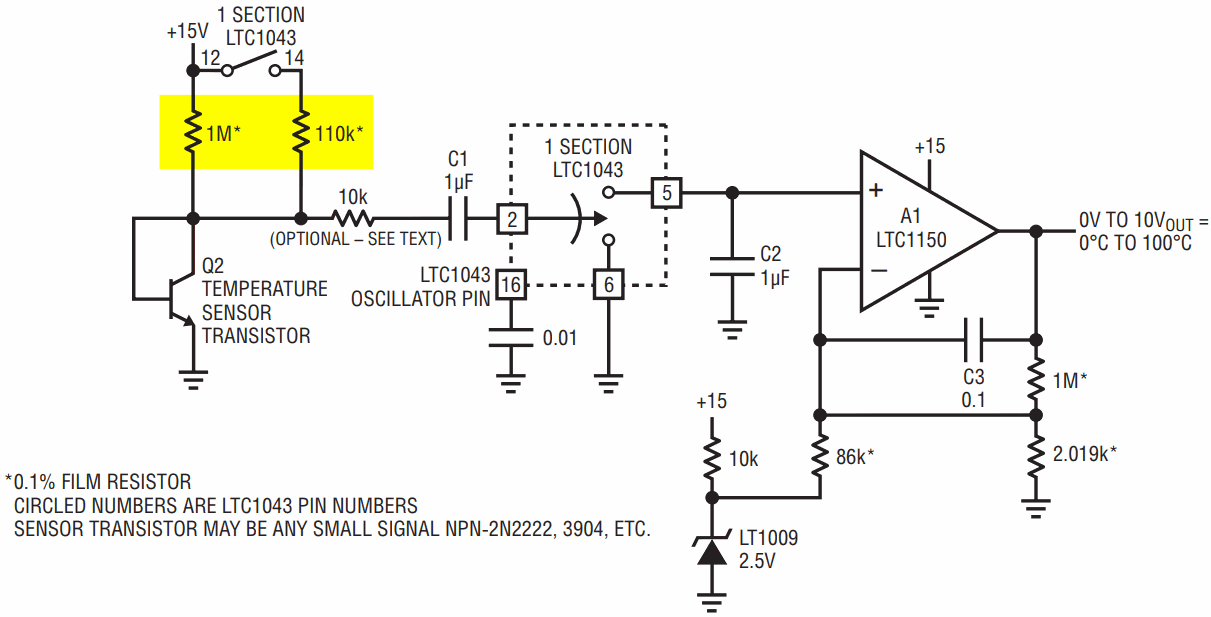On June 12, 2011, the analog EE world lost a star when guru James M. Williams died. Jim’s hundreds of articles, books, and application notes were (and continue to be) a bottomless wellspring of information, inspiration, and the joy of seeing thorny design puzzles handily solved by a master, all wrapped up in a delightful writing style. The design idea presented here derives from one of his circuits published on page 7 of AN45.
In his note, Jim discusses the appeal of using transistor VBE tempco as an inexpensive temperature sensor, but how in practice, its utility is limited by unpredictable transistor-to-transistor VBE variability. He explains how this problem necessitates initial sensor transistor calibration (and recalibration if the sensor ever needs replacement), which mostly cancels any expected convenience and cost savings.
Then Jim saves the day with an ingenious solution.
It turns out, says Jim, that although the constant-current VBE of a random transistor isn’t usefully predictable, BJT VBE change with variable-current is very predictable.
Specifically, it reliably obeys this simple logarithmic equation…

where TABS = absolute temperature in °Kelvin. Therefore, when used as a thermometer…

if

Note the cool (and easily remembered) “fifty-fifty” constant!
Jim applies this relationship in the Figure 1 topology that’s said to put a 10:1 bias current cycle [1] onto Q2’s diode-connected NPN transistor, synchronously rectify the resulting 198 µVpp/K AC waveform, then amplify and offset the resulting DC to produce a 0 to 10 V = 0 to 100 °C, no sensor-transistor-specific calibration required, output.
 |
|
| Figure 1. | Jim Williams’s ∆VBE-based thermometer. |
I’ve used “fifty-fifty” in many successful thermometric applications and offer a new variation on the idea here in Figure 2’s K-degrees-to-microseconds oscillator.
 |
|
| Figure 2. | An oscillator that is an absolute thermometer. |
The ∆VBE current ratio is set here by the R3/R4 resistor pair (plus a small contribution from the R1+R2 integrator network) to 16:1. This creates a temperature-proportional ∆VBE periodic step on A2 pin 7 of:

whenever the A1 comparator switches the Q2 FET. I chose the larger 16 versus 10:1 current ratio to provide a somewhat easier signal for the op-amps to process, and to reduce the importance of some secondary potential error sources. C2 provides positive feedback to ensure the comparator transitions are quick and clean.
The A2 integrator then ramps from the ∆VBE step back toward A1’s 500 mV setpoint as shown in Figure 3, generating symmetrical half-cycle timeouts of duration T = 10 µs/K = 3 ms at 300 K = 27 °C.
 |
|
| Figure 3. | Thermometer oscillator waveforms. |
Although as noted in the Willams application, the Q1 sensor transistor itself needs no calibration. Trimmer R1 is provided as one-point compensation mainly for integrator capacitor C1 and VDD tolerances. Once R1 is adjusted, it need not be revisited even if Q1 is replaced.
The thermometer oscillator’s 0/5 V output can be conveniently converted to a digital temperature readout by standard microcontroller timer hardware. At a clock rate of 1 MHz, conversion resolution over one oscillation half-cycle period T is 0.1°.
A typo apparently somehow slipped through into Jim’s schematic. The resistor pair that’s said to set the 10:1 current ratio and therefore should be in a 9:1 resistance ratio, are in fact 549k/49.9k = 11:1, would set 12:1 currents, and therefore a scale factor of 214 µV/K; not the stated 198 µV. I don’t know if a revised edition exists that corrects this minor 8% hiccup, but it’s a simple fix which I have taken the liberty to do. Also, Q1 is unnecessary.